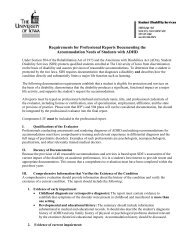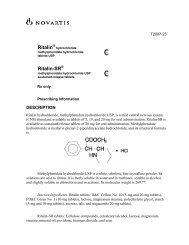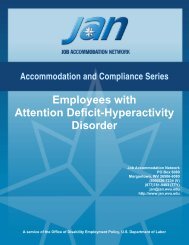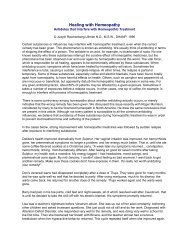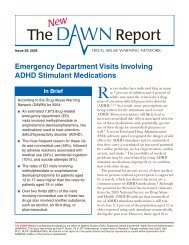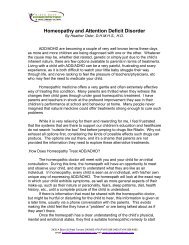Documentation Requirements for Attention ... - ADHD Info Centre
Documentation Requirements for Attention ... - ADHD Info Centre
Documentation Requirements for Attention ... - ADHD Info Centre
Create successful ePaper yourself
Turn your PDF publications into a flip-book with our unique Google optimized e-Paper software.
Dean of Students Office<br />
Disability Resources<br />
<strong>Documentation</strong> <strong>Requirements</strong> <strong>for</strong> <strong>Attention</strong>-Deficit<br />
Disorder/<strong>Attention</strong>-Deficit Hyperactivity Disorder<br />
(ADD/<strong>ADHD</strong>)<br />
I. A Qualified Professional Must Conduct the Evaluation<br />
A. The name, title, and professional credentials of the evaluator, including in<strong>for</strong>mation about<br />
license or certification, as well as the area of specialization and state or province in which the<br />
individual practices should be clearly stated in the documentation. Comprehensive training in<br />
the differential diagnosis and the full range of psychiatric disorders, as well as, direct<br />
experience with an adolescent or adult <strong>ADHD</strong> population are essential.<br />
B. This documentation should be completed by a psychologist, neuropsychologist, school<br />
psychologist, psychiatrist, or other relevantly trained medical doctor, who has direct knowledge<br />
of you and your disability. It may be appropriate to use a clinical team approach consisting of a<br />
variety of educational, medical, and counseling professionals with training in the evaluation of<br />
<strong>ADHD</strong>.<br />
C. All reports must be on letterhead, typed, dated, and bear the signature of the evaluator.<br />
Originals can be returned to student, if requested.<br />
D. Competence in working with culturally and linguistically diverse populations is also essential.<br />
It is of utmost importance that evaluators are sensitive and respectful of cultural and linguistic<br />
differences.<br />
II.<br />
<strong>Documentation</strong> Must Be Current<br />
A. <strong>Documentation</strong> must be current. Because the provision of reasonable accommodations and<br />
services is based upon UF's assessment of the current impact of the disability on academic<br />
per<strong>for</strong>mance, it is in a student's best interest to provide recent and appropriate documentation.<br />
B. It is important to recognize that accommodation needs can change over time and are not always<br />
identified through the initial diagnostic process. Conversely, a prior history of accommodations<br />
does not, in and of itself, warrant the provision of a similar accommodation.<br />
C. In most cases, this means that a diagnostic evaluation must have been completed within the<br />
past five years. If documentation is inadequate in scope or content, or does not address the<br />
individual's current level of functioning and need <strong>for</strong> accommodations, re-evaluation may be<br />
required.<br />
D. In addition, changes may have occurred in the individual's per<strong>for</strong>mance since the
assessment, or new medications may have been prescribed or discontinued, which would result<br />
in the necessity of an update in the evaluation report. The update must include a detailed<br />
assessment of the current impact of the <strong>ADHD</strong> and interpretive summary of relevant<br />
in<strong>for</strong>mation (see requirement #VI below) as well as the previous diagnostic report.<br />
III. <strong>Documentation</strong> Necessary to Substantiate the Diagnosis Must Be<br />
Comprehensive<br />
A. Standard scores and/or percentiles must be provided <strong>for</strong> all normed measures. Grade<br />
equivalents must be accompanied with standard scores and/or percentiles.<br />
B. The data must logically reflect a substantial limitation to learning <strong>for</strong> which the student is<br />
requesting accommodation.<br />
C. The particular profile of the student's strengths and weaknesses must be shown to relate to<br />
functional limitations that may necessitate accommodations.<br />
D. The testing instruments must be reliable, valid, and standardized <strong>for</strong> use with a adolescent/adult<br />
population.<br />
E. In<strong>for</strong>mal inventories, surveys, self reports, and direct observation by a qualified professional<br />
may be used in tandem with <strong>for</strong>mal tests in order to further develop a clinical hypothesis.<br />
F. Evidence of Early Impairment<br />
Because <strong>ADHD</strong> is, by definition in the DSM-IV, first exhibited in childhood (although it may<br />
not have been <strong>for</strong>mally diagnosed) and manifests itself in more than one setting, relevant<br />
historical in<strong>for</strong>mation is essential. The following should be included in a comprehensive<br />
assessment: clinical summary of objective historical in<strong>for</strong>mation, establishing symptomology<br />
indicative of <strong>ADHD</strong> throughout childhood, adolescence, and adulthood as garnered from<br />
transcripts, report cards, teacher comments, tutoring evaluations, and past psycho-educational<br />
testing; and third party interviews when available.<br />
G. Evidence of Current Impairment<br />
In addition to providing evidence of a childhood history of impairment, the following areas<br />
must be investigated:<br />
1. Statement of Presenting Problem<br />
A history of the individual's presenting attentional symptoms should be provided, including<br />
evidence of ongoing impulsive/hyperactive or inattentive behaviors that significantly impair<br />
functioning in two or more settings.<br />
2. Diagnostic Interview<br />
The in<strong>for</strong>mation collected <strong>for</strong> the summary of the diagnostic interview should consist of more<br />
than self-report, as in<strong>for</strong>mation from third party sources is critical in the diagnosis of <strong>ADHD</strong>.
The diagnostic interview with in<strong>for</strong>mation from a variety of sources should include, but not<br />
necessarily be limited to, the following:<br />
• history of presenting attentional symptoms, including evidence of ongoing<br />
impulsive/hyperactive or inattentive behavior that has significantly impaired functioning<br />
over time;<br />
• developmental history;<br />
• family history <strong>for</strong> presence of <strong>ADHD</strong> and other educational, learning, physical, or<br />
psychological difficulties deemed relevant by the examiner;<br />
• relevant medical and medication history, including the absence of a medical basis <strong>for</strong> the<br />
symptoms being evaluated;<br />
• relevant psychosocial history and any relevant interventions,<br />
• a thorough academic history of elementary, secondary, and postsecondary education-,<br />
• a review of prior psychoeducational test reports to determine whether a pattern of strengths<br />
or weaknesses is supportive of attention or learning problems;<br />
• relevant employment history ;<br />
• description of current functional limitations pertaining to an educational setting that are<br />
presumably a direct result of problems with attention, and<br />
• relevant history of prior therapy.<br />
Alternative Diagnoses or Explanations Should Be Ruled Out<br />
• The evaluator must investigate and discuss the possibility of dual diagnoses and alternative or<br />
coexisting mood, behavioral, neurological, and/or personality disorders that may confound the<br />
diagnosis of <strong>ADHD</strong>. This process should include exploration of possible alternative diagnoses<br />
and medical and psychiatric disorders as well as educational and cultural factors affecting the<br />
individual that may result in behaviors mimicking an <strong>Attention</strong>-Deficit/Hyperactivity Disorder.<br />
• Medical disorders may cause symptoms resembling <strong>ADHD</strong>. There<strong>for</strong>e, it may be important to<br />
rule out Neuroendocrine disorders (e.g., thyroid dysfunction), Neurologic disorders, as well as<br />
other disorders, and impact of medication on attention if tried, and under what circumstances.<br />
3. Relevant Testing In<strong>for</strong>mation Must Be Provided<br />
Neuropsychological or psychoeducational assessment is important in determining the current<br />
impact of the disorder on the individual's ability to function in academically related settings.<br />
The evaluator must objectively review and include with the evaluation report relevant<br />
background in<strong>for</strong>mation to support the diagnosis. If grade equivalents are reported, they must
e accompanied by standard scores and/or percentiles. Test scores or subtest scores alone<br />
should not be used as a sole measure <strong>for</strong> the diagnostic decision regarding <strong>ADHD</strong>. Selected<br />
subtest scores from measures of intellectual ability, memory functions tests, attention or<br />
tracking tests, or continuous per<strong>for</strong>mance tests do not in and of themselves establish the<br />
presence or absence of <strong>ADHD</strong>. Checklists and/or surveys can serve to supplement the<br />
diagnostic profile but in and of themselves are not adequate <strong>for</strong> the diagnosis of <strong>ADHD</strong> and do<br />
not substitute <strong>for</strong> clinical observations and sound diagnostic judgment. All data must logically<br />
reflect a substantial limitation to learning <strong>for</strong> which the individual is requesting the<br />
accommodation.<br />
Acceptable instruments include, but are not limited to:<br />
Rating Scales<br />
• Conners Teacher Rating Scale (age 3-17 years)<br />
• Conners Parent Rating Scale (age 3-17years)<br />
Aptitude/Cognitive Ability<br />
• Wechsler Adult Intelligence Scale - III (WAIS-111)<br />
• Woodcock-Johnson Psychoeducational Battery - Revised: Tests of Cognitive Ability<br />
• Kaufman Adolescent and Adult Intelligence Test<br />
• Stan<strong>for</strong>d-Binet Intelligence Scale (4 th ed.)<br />
The Slosson Intelligence Test - Revised and the Kaufman Brief<br />
Intelligence Test are primarily screening devices which are not<br />
comprehensive enough to provide the kinds of in<strong>for</strong>mation necessary to<br />
make accommodation(s) decisions.<br />
Academic Achievement<br />
• Scholastic Abilities Test <strong>for</strong> Adults (SATA)<br />
D. Stan<strong>for</strong>d Test of Academic Skills (TASK)<br />
• Woodcock-Johnson Psychoeducational Battery - Revised: Tests of Achievement<br />
• Wechsler Individual Achievement Test (WIAT)<br />
or specific achievement tests such as<br />
• Nelson-Denny Reading Skills Test<br />
• Stan<strong>for</strong>d Diagnostic Mathematics Test<br />
• Test of Written Language - 3 (TOWL-3)<br />
• Woodcock Reading Mastery Tests - Revised
In<strong>for</strong>mation Processing<br />
• Detroit Tests -of Learning Aptitude - 3 (DTLA-3)<br />
• Detroit Tests of Learning Aptitude - Adult (DTLA-A).<br />
• In<strong>for</strong>mation from subtests on WAIS-R or Woodcock-Johnson Psychoeducational Battery -<br />
Revised: Tests of Cognitive Ability, as well as other relevant instruments, may be useful<br />
when interpreted within the context of other diagnostic in<strong>for</strong>mation.<br />
4. Identification of DSM-IV Criteria<br />
According to the DSM-IV, "the essential feature of <strong>ADHD</strong> is a persistent pattern of inattention<br />
and/or hyperactivity-impulsivity that is more frequent and severe than is typically observed<br />
individuals at a comparable level of development" (p. 78). A diagnostic report should include a<br />
review and discussion of the DSM-IV criteria <strong>for</strong> <strong>ADHD</strong> both currently and retrospectively and<br />
specify which symptoms are present (see DSM-IV <strong>for</strong> complete criteria).<br />
In diagnosing <strong>ADHD</strong>, it is particularly important to address the following criteria:<br />
• symptoms of hyperactivity/impulsivity or inattention that cause impairment that must<br />
have been present in childhood;<br />
• current symptoms that have been present <strong>for</strong> at least the past six months;<br />
• impairment from the symptoms present in two or more settings (<strong>for</strong> example, school,<br />
work, home);<br />
• clear evidence of significant impairment in social, academic, or occupational<br />
functioning*; and<br />
• symptoms that do not occur exclusively during the course of a Pervasive<br />
Developmental Disorder, Schizophrenia, or other Psychotic Disorder and are not better<br />
accounted <strong>for</strong> by another mental disorder (e.g., Mood Disorder, Anxiety Disorder,<br />
Dissociative Disorder, and a Personality Disorder).<br />
IV.<br />
<strong>Documentation</strong> Must Include a Specific Diagnosis<br />
A. The report must include a specific diagnosis of the disability. The diagnostician should use<br />
direct language in the diagnosis of the disability, avoiding such terms as "suggest" or "is<br />
indicative of”.<br />
B. The report must include a specific diagnosis of <strong>ADHD</strong> based on the DSM-IV diagnostic<br />
criteria.<br />
C. The diagnostician should use direct language in the diagnosis of <strong>ADHD</strong>, avoiding the use of<br />
such terms as "suggests ... .. is indicative of," or "attention problems."<br />
D. Individuals who report only problems with organization, test anxiety, memory or concentration<br />
in selective situations do not fit the prescribed diagnostic criteria <strong>for</strong> <strong>ADHD</strong>.
E. Given that many individuals benefit from prescribed medications and therapies, a positive<br />
response to medication by itself does not confirm a diagnosis, nor does the use of medication in<br />
and of itself either support or negate the need <strong>for</strong> accommodation(s).<br />
V. Each Accommodation Recommended by the Evaluator Must Include a<br />
Rationale<br />
A. The evaluator must describe the impact, if any, of the diagnosed <strong>ADHD</strong> on a specific major life<br />
activity as well as the degree of impact on the individual. The diagnostic report must include<br />
specific recommendations <strong>for</strong> accommodations that the post-secondary institution can<br />
reasonably provide.<br />
B. A detailed explanation as to why each accommodation is recommended must be provided and<br />
should be correlated with specific functional limitations determined through interview,<br />
observation, and/or testing.<br />
C. The documentation must include any record of prior accommodations or auxiliary aids,<br />
including in<strong>for</strong>mation about specific conditions under which the accommodations were used<br />
(e.g., standardized testing, final exams, licensing or certification examinations) and whether or<br />
not they benefited the individual. However, a prior history of accommodations without<br />
demonstration of a current need does not in itself warrant the provision of like<br />
accommodations.<br />
D. Although prior documentation may have been useful in determining appropriate services in the<br />
past, current documentation must validate the need <strong>for</strong> services based on the individual's<br />
present level of functioning in the educational setting.<br />
E. A school plan such as an Individualized Education Program (IEP) or a 504 plan is insufficient<br />
documentation in and of itself but can be included as part of a more comprehensive evaluative<br />
report.<br />
F. If no prior accommodations were provided, the qualified professional and/or the candidate must<br />
include a detailed explanation of why no accommodations were needed in the past and why<br />
accommodations are needed at this time.<br />
G. Because of the challenge of distinguishing normal behaviors and developmental patterns of<br />
adolescents and adults (e.g., procrastination, disorganization, distractibility, restlessness,<br />
boredom, academic under-achievement or failure, low self-esteem, chronic tardiness or lack of<br />
attendance) from clinically significant impairment, a multifaceted evaluation should address the<br />
intensity and frequency of the symptoms and whether these behaviors constitute an impairment<br />
in a major life activity.<br />
H. The evaluator should support recommendations with specific test results or clinical<br />
observations.
I. The DR will make the final determination as to whether appropriate and reasonable<br />
accommodations are warranted and can be provided to the student. If the student is not satisfied<br />
with the determination, an appeal can be made through the University of Florida's ADA<br />
Coordinator within 180 days.<br />
VI.<br />
An Interpretative Summary Must Be Provided<br />
A. An interpretative summary based on a comprehensive evaluative process is a necessary<br />
component of the documentation. Because <strong>ADHD</strong> is in many ways a diagnosis that is based<br />
upon the interpretation of historical data and observation, as well as other diagnostic<br />
in<strong>for</strong>mation, it is essential that professional judgment be utilized.<br />
B. A clinical summary must include:<br />
1 . Indication that the evaluator ruled out alternative explanations <strong>for</strong> inattentiveness, impulsivity,<br />
and/or hyperactivity as a result of other disorders or non-cognitive factors.<br />
2. Indication, of how patterns of inattentiveness, impulsivity, and/or hyperactivity across the life<br />
span and across settings are used to determine the presence of <strong>ADHD</strong>.<br />
3. Indication of whether or not the candidate was evaluated while on medication, and whether or<br />
not the prescribed treatment produced a positive response.<br />
4. Indication and discussion of the substantial limitation to learning presented by the <strong>ADHD</strong> and<br />
the degree to which it affects the individual in the testing context <strong>for</strong> which accommodations<br />
are being requested.<br />
5. Indication as to why specific accommodations are recommended and how the effects of <strong>ADHD</strong><br />
symptoms, as designated by the DSM-IV, would be mediated by the accommodations.<br />
These guidelines were adapted from documents/books developed by,<br />
Association on Higher Education and Disability (AHEAD).<br />
Educational Testing Service @ 1997 and 1998. All rights reserved.<br />
Accommodations in Higher Education Under the Americans. with Disabilities Act (ADA); Edited by Michael Gordon and Shelby<br />
Keiser.<br />
The primary intent of this document was to develop standard criteria <strong>for</strong> documentation used to determine appropriate accommodations<br />
<strong>for</strong> individuals with LD and cognitive impairments.<br />
Revised: 9/99



